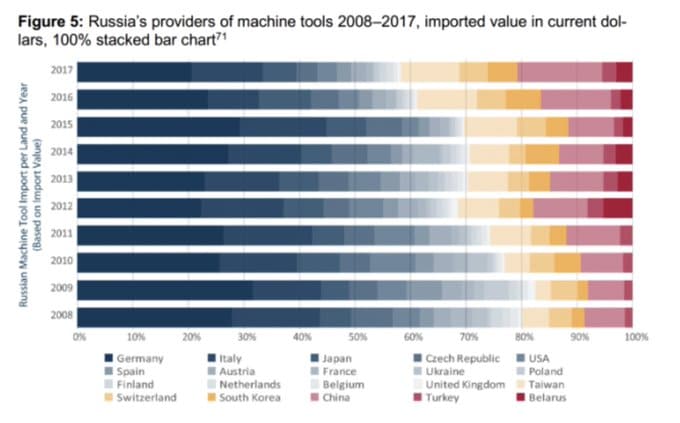In just a few short weeks, the war in Ukraine will surpass the 5-month mark. Thousands of civilians have died, and tens of thousands of soldiers have perished. And all the while, the Russian Federation has fired thousands of missiles and spent billions on armaments. Ukraine, with far smaller military capacity, has only persevered through the onslaught thanks to the support of massive aid packages from the West.
But Russia has been sanctioned, not supported. How has it managed to slog through months of military expenditure?
Who’s backing the Russian military industry?
If you answered China, you’d be wrong. In actual fact, the Russian military industry is backed largely by Europe. Almost all Russian military production equipment is imported – largely from Germany, but also from Switzerland, Japan, the US, just to name a few. There’s even anecdotal evidence of Russia using Aussie and Turkish equipment. But never Chinese.

Kamil Galeev, researcher with the Wilson Centre and journalist, has a few hypotheses.
First, the Chinese military industry shares similar bottlenecks or ‘chokepoints’ as Russia – for example, in some high-end technological components. This observation is corroborated by analysis by the likes of Ben Murphy of the Georgetown Center for Security and Emerging Technology. But this alone doesn’t account for the blanket absence of any Chinese assistance.
Another potential factor may be plain old racism. Post-Soviet Russia is certainly not the most racially progressive society. While China may have allied politically with Russia and the USSR in the past, culturally most Russians view Chinese (and other non-white ethnicities) as inferior. But the Kremlin still imports military industry from Turkey, so again, racism is an insufficient explanation.
A special kind of ‘Sinophobia’
Galeev puts most of eggs in the ‘Sinophobia’ basket. This is not only racism, but a broader fear of China’s military and productive potential; the risk it poses. Galeev believes import from China is the only import prohibited in the Russian military industry in reality.
Overly strict requirements for import substitution of machine tools in the military have been in place since 2014. Suppliers have gotten around these regulations by simply buying foreign tools and then passing them off as Russian-made. The FSB turns a blind eye because enforcing regulations would debilitate the industry.
But not so with Chinese imports. Galeev suggests this selective enforcement is due to a Russian fear of Chinese retaliation in case of a Sino-Russian conflict. With imports from the West, Russia operates under the assumption the West is not unified, and so supply chains would be easier to deal with in the event of a conflict.
But China poses a unified front in the Kremlin’s mind. The risks would be unmanageable. As Galeev points out, Sino-Russian alliance should not be taken for granted as absolute. “While the political leadership inclined to China, the apparatus as a whole distanced from it,” he says, “That’s why “alignment” was so idiosyncratic.”
The war in Ukraine may have changed this. The West’s relatively unified response, both with sanctions and industrial support for Zelensky, may have rendered the risks of Western military import just as ‘unmanageable’.
You can read Kamil Galeev’s full Twitter thread on the topic here.
Follow Maddie’s journalism on Twitter.
Sign Up To Our Free Newsletter